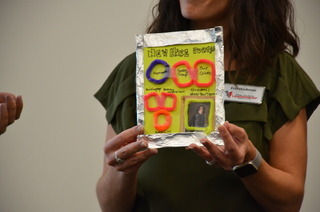Text
Make It OK.
“Use your smile to change the world; don’t let the world change your smile.” - Unknown
“One of the most powerful things the world shares is the universal smile. A smile can cut through all barriers. It knows no age, gender, color or culture. No matter where you are in the world, what language you speak, or social status, a smile will always be understood.
A smile represents something bigger than itself. A smile represents goodwill, affection and openness towards others. It communicates happiness and acceptance. It is one thing that connects and encompasses us all. When we smile, it makes those around us feel good, happy and loved.” - Megan Bailey
GDMLI Class of 2020 spent an afternoon listening, learning, reflecting, sharing and empowering one another to talk about wellness and mental health. Laura Jackson from Wellmark took the stage and shared that she smiled at each of us as we walked into class, and only received a few smiles back. Hearing this made me sad. Laura quickly lifted us up (physically getting out of our seats!) and shared information on the health of millennial's, specifically in Iowa. Statistics show millennial health starts to decline at age 27 and that there’s been significantly more diagnosis of mental health claims in recent years (perhaps due to more people dealing with a mental health concern, or more people choosing to talk to someone about it). Laura shared a variety of mental/emotional health concerns that are arising, and that many of them can be prevented or reversed through eating well, moving more, and socially connecting.

As Laura wrapped up her session we, as community leaders learned ways we can impact the perception and stigma around mental health. In our work environments, we can remove stigma, monitor stress, and nudge coworkers to move more and eat healthy. We can continue to educate ourselves and others through connecting with resource groups and communities, rename our Employee Assistance Programs and teach financial wellness. We can talk to our HR teams about preventative health PTO and encourage one another to form relationships with our personal doctors. Our class committed to being better, doing more, and driving change.
Jen Ulie-Wells (Please Pass the Love), took a few minutes to chat with us about youth mental health and how youth trauma can play a significant part in negative physical and mental health outcomes as an adult. She shared personal stories that inspired us to engage with others.
Jami Haberl (Healthiest State Initiative) brought energy in sharing the Make It OK campaign, and how one in five adults experience a mental health concern or illness. A part of her presentation really hit me, something I’ve been thinking about since then...
“If I walked into the room with a large cut on my leg, you’d all likely rush over and ask how you could help or just start treating my physical pain.”
“If I stood up here and told you I was recently diagnosed with cancer, you’d all likely feel sad, ask how you could help, maybe even jump in and make plans for supporting me through treatment by bringing meals or helping out around my house. But, what would happen if I stood up here and shared with you that I suffer from severe anxiety and depression? Would you offer to help, support my treatment plan, bring me meals? Would you even know what to say?” The room was silent, as we reflected on this comparison. Why would we treat people with two diagnosed conditions so differently, just because one was mental and another physical? It doesn’t feel right. We need to be better about making it OK to talk about mental health struggles just like we would a physical injury. I’m confident if my friend broke her leg, I’d be checking in on her, driving her to appointments, helping her with cooking, cleaning, and transportation. But have I been doing those things for my friends struggling with a mental illness? Do I even know which of my friends are struggling, do I ask those questions, and offer the same level of help? I don’t know that I was in the past, but that changes today.
Mental health issues are as common as silver cars. We need to make it ok to talk about in our homes, with our friends, coworkers, and support groups. Jami challenged us to commit to doing one thing every day to Make It OK.

Later we had a chance to break into small groups to dive deeper into the policy in place around mental health in our state. Erin Drinnin with United Way shared that youth mental health resources are slim, and that recent changes have been made to address screening, assessment and evaluation, medications and therapeutic services and hospital and residential care, but much more needs to be done to better support our youth. Karen Rieck from Farm Bureau, shared many facets of mental health: intellectual, environmental, social, physical, spiritual, financial, emotional, and occupational. When is the last time we took a minute to assess how we are doing in all these areas, and are there ways we can make changes for improvement or seek support? She shared how we can utilize our Employee Resource Program and be assured those details are not shared with our employer. More people need to take advantage!
The day ended reflecting on how we can be advocates, leaders, and drivers of change when it comes to removing the stigma around mental illness and championing ways to improve mental health in our community.

It’s OK to have a mental illness - many people do.
It’s OK to talk about mental illness - talking makes people feel less alone.
It’s OK to get help with mental illness - life can get better.
-Make It OK.org/Iowa

0 notes
Text
Design Thinking
Design Thinking - Approach to Social Change
Community Leadership Class of 2020 will be the first group to use Design Thinking as part of our class projects! We spent the morning on Thursday, September 5th, at Principal Financial learning about this process for creative problem-solving. Design Thinking takes the approach that problem-solvers should put the humans they are serving at the core. The strategy helps teams focus on the people who we are creating for, to produce better products and services. The diagram below shows a brief outline of the key components of Design Thinking.

Empathize - Focus on the user, understand their needs and take the next steps with their best interest in mind.
Define - Put the problem into a statement… “How might we…”
Ideate - Creative time! The volume of ideas is greater than the perfect solution
Prototype - Helps get a reaction and allows for testing and the opportunity to raise questions
Test - Try it out, make changes to continually improve the process!
Below are a few photos of our project teams practicing our newly learned Design Thinking skills.
Our guest leader Lisa Rossi, spent time interviewing Mike for us to get the process started. We listened intently and took detailed notes on his experiences with his first days on a new job to complete the empathize step.
Lisa then helped us define our question “How might Mike have a great first day of work?”.
Next, we had to ideate! We grabbed sticky notes, and rapidly wrote down our individual ideas and created a plethora of suggestions at the center of our tables. We each chose our top 3, and used the dot method to vote for our favorite ones. The idea with the most dots was the one we would use, and we began our prototype step!

Teams used paper, markers, glue, pipe cleaners, playdough, and many other fun tools to create prototypes. In a short amount of time, we crafted creative, unique and somewhat silly ideas to help improve Mike’s first day of work! We had 2 minutes to share our prototype idea with the class and how we would test it!

It was really fun to see each group came up with fun, energizing ideas to answer “How might Mike have a great first day of work?”!


This was our first chance to work together as a project team, alongside our community partners, to generate ideas, share opinions, listen intently and come to a solution as a team! The initial trial of Design Thinking was thought-provoking, conversation-generating, and confidence-boosting! Check out some of the prototypes below! CLP class of 2020 is excited to use our new skills and problem-solving process of Design Thinking as we start to dive into our projects with our community partners! #GDMLI #CLP2020
1 note
·
View note